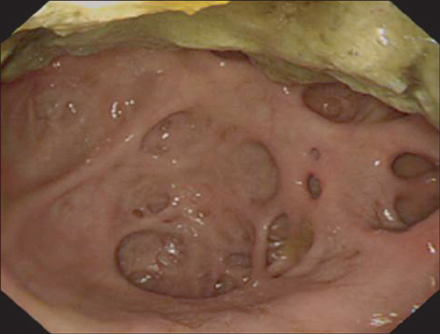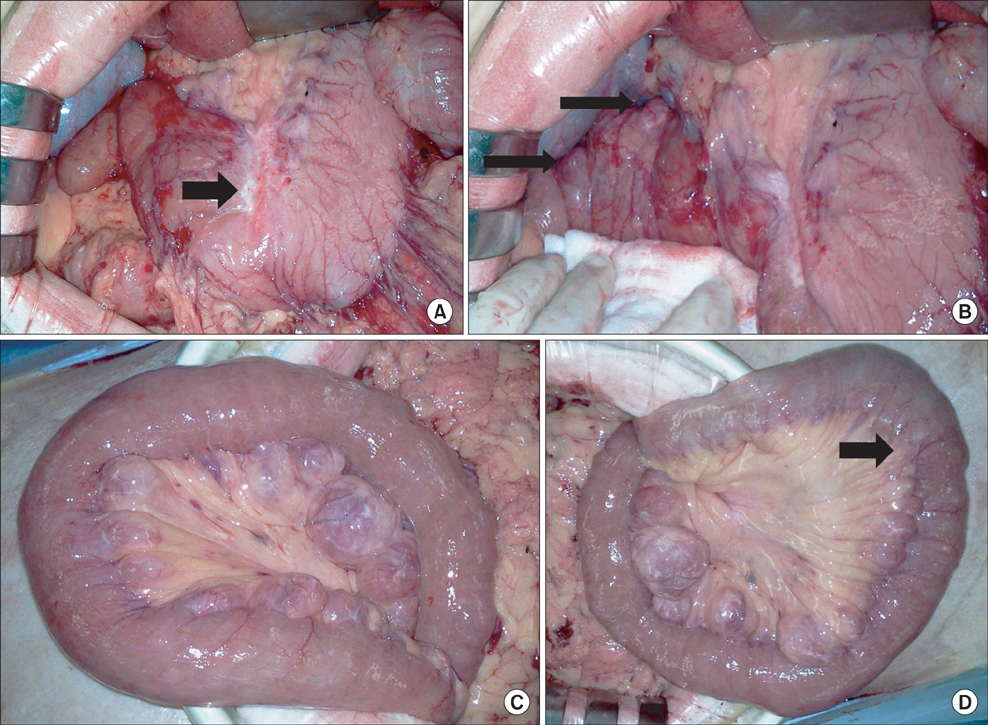Ann Surg Treat Res.
2014 Oct;87(4):209-212. 10.4174/astr.2014.87.4.209.
Small bowel diverticulosis in patient with early gastric cancer
- Affiliations
-
- 1Department of Surgery, Konkuk University Medical Center, Konkuk University School of Medicine, Seoul, Korea. 20090445@kuh.ac.kr
- KMID: 1882827
- DOI: http://doi.org/10.4174/astr.2014.87.4.209
Abstract
- Jejunal and ileal diverticula are rare in adults. Duodenal diverticula are five times more prevalent than jejunoileal diverticula. Most patients are asymptomatic. However, chronic symptoms including intermittent abdominal pain, flatulence, diarrhea and constipation are seen in 10%-30% of patients. Gastric cancer is the second most common cancer in South Korea and here we report a case of early gastric cancer with multiple duodenal and jejunal diverticula. A 67-year-old woman was admitted to Konkuk University Medical Center with chronic diarrhea and weight loss of 19 kg over 2 months. Following gastroduodenoscopy, we identified adenocarcinoma of the lower body of the stomach. On abdominopelvic computed tomography, diverticula of duodenum and jejunum were found. Patient underwent distal gastrectomy and gastroduodenostomy with lymphadenectomy. She was discharged on the tenth postoperative day without complications.
MeSH Terms
Figure
Reference
-
1. Longo WE, Vernava AM 3rd. Clinical implications of jejunoileal diverticular disease. Dis Colon Rectum. 1992; 35:381–388.2. Akhrass R, Yaffe MB, Fischer C, Ponsky J, Shuck JM. Small-bowel diverticulosis: perceptions and reality. J Am Coll Surg. 1997; 184:383–388.3. Choi JJ, Ogunjemilusi O, Divino CM. Diagnosis and management of diverticula in the jejunum and ileum. Am Surg. 2013; 79:108–110.4. Jung KW, Won YJ, Kong HJ, Oh CM, Seo HG, Lee JS. Cancer statistics in Korea: incidence, mortality, survival and prevalence in 2010. Cancer Res Treat. 2013; 45:1–14.5. Thorson CM, Paz Ruiz PS, Roeder RA, Sleeman D, Casillas VJ. The perforated duodenal diverticulum. Arch Surg. 2012; 147:81–88.6. Woods K, Williams E, Melvin W, Sharp K. Acquired jejunoileal diverticulosis and its complications: a review of the literature. Am Surg. 2008; 74:849–854.7. Koger KE, Shatney CH, Dirbas FM, McClenathan JH. Perforated jejunal diverticula. Am Surg. 1996; 62:26–29.8. Lee BG, Park SB, Byun CG, Koh YT, Suh DY, Park DS, et al. Localized peritonitis due to perforation of multiple jejunal diverticula. J Korean Surg Soc. 2004; 67:75–78.9. Kassahun WT, Fangmann J, Harms J, Bartels M, Hauss J. Complicated small-bowel diverticulosis: a case report and review of the literature. World J Gastroenterol. 2007; 13:2240–2242.
- Full Text Links
- Actions
-
Cited
- CITED
-
- Close
- Share
- Similar articles
-
- Uncomplicated jejunal diverticulosis with pneumoperitoneum
- A Case of Small Bowel GIST Initially Suspected as Peritoneal Seeding of Gastric Cancer
- Screening of gastric cancer
- A Case of Early Gastric Cancer Associated with Small Cell Lung Cancer
- Endoscopic Treatment of a Twisted Small Bowel Obstruction after Laparoscopic Proximal Gastrectomy with Double Tract Reconstruction




